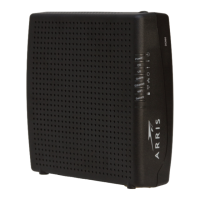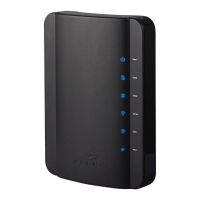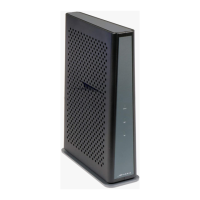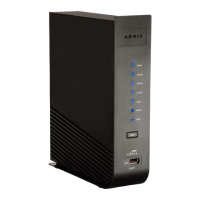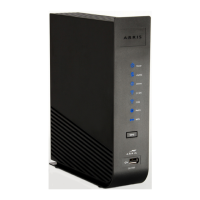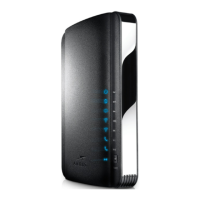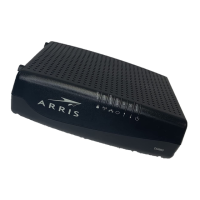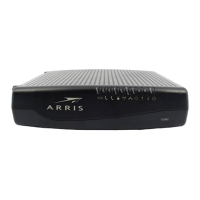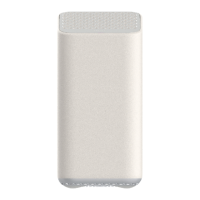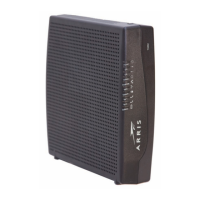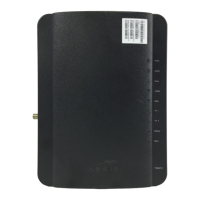Do you have a question about the Arris Touchstone DG2470 and is the answer not in the manual?
Introduces the Touchstone DG2470 Data Gateway, its features, and benefits for internet connectivity.
Provides contact information and website for assistance with the ARRIS product.
Lists essential safety guidelines for using the Data Gateway, including electrical and environmental concerns.
Details FCC compliance requirements and measures to correct interference for digital devices.
States compliance with FCC radiation exposure limits and installation guidelines for safe operation.
Outlines compliance with Industry Canada regulations for radio transmitters and devices.
Specifies operating conditions for equipment in Mexico according to national regulations.
Describes the Touchstone DG2470's features, DOCSIS compliance, and connectivity options.
Lists all items included in the Data Gateway package for initial setup.
Guides users on contacting their cable company to establish internet service and account.
Details the necessary computer and operating system requirements for using the Data Gateway.
Provides essential tips for enhancing system security and protecting your network.
Discusses the advantages and considerations of connecting via Ethernet versus wireless.
Details the indicators and their functions on the front panel of the Data Gateway.
Describes the connectors and controls located on the rear panel of the Data Gateway.
Provides factors to consider when choosing a suitable physical location for the Data Gateway.
Step-by-step instructions for connecting the Data Gateway's coaxial cable to the network.
Guides users on setting up the wireless LAN security and connecting devices to the network.
Provides instructions on how to access and navigate the Data Gateway's web-based configuration interface.
Lists the necessary prerequisites before attempting to configure the Ethernet connection.
Step-by-step guide for configuring TCP/IP settings on a Windows XP operating system.
Instructions for configuring TCP/IP settings on a Windows Vista operating system.
Guide for setting up TCP/IP configurations on Windows 7 and Windows 8 operating systems.
Details the process of configuring TCP/IP settings for the MacOS X operating system.
Refers to instructions in the cable company's information packet for setting up your computer.
Explains the meaning of the LED indicator lights on the Data Gateway for troubleshooting.
Shows LED patterns for Ethernet, MoCA, and wireless LANs during normal operation.
Displays LED light patterns for Power, US/DS, and Online during normal WAN operation.
Outlines the sequence of LED status changes during the cable modem startup process.
Instructs on how to reset the router to factory default settings via the reset button.
Provides steps to troubleshoot when the Data Gateway's power light is off.
Guides on troubleshooting no internet connection across all devices and connections.
Offers solutions for internet connectivity issues specifically with Ethernet connections.
Provides troubleshooting steps for wireless internet connection problems.
Addresses intermittent wireless connection issues, often caused by interference.
Offers advice for slow internet speeds, considering website load and network congestion.
Defines Data Over Cable System Interface Specification standards for data communications.
Defines Ethernet as a standard method for Local Area Network connections.
Defines Firewall as a device preventing unauthorized network access to a private network.
Defines Gateway as a router connecting devices on IP subnets to other IP subnets.
Defines IP address as a number identifying a computer to other systems on the Internet.
Defines LAN as Local Area Network for communication between computers in a single location.
Defines MAC address as a unique identifier for any device connected to a network.
Defines TCP/IP as protocols facilitating communications across connected networks.
Defines WPA as Wi-Fi Protected Access, a standard for encrypting wireless data.
Introduces the Touchstone DG2470 Data Gateway, its features, and benefits for internet connectivity.
Provides contact information and website for assistance with the ARRIS product.
Lists essential safety guidelines for using the Data Gateway, including electrical and environmental concerns.
Details FCC compliance requirements and measures to correct interference for digital devices.
States compliance with FCC radiation exposure limits and installation guidelines for safe operation.
Outlines compliance with Industry Canada regulations for radio transmitters and devices.
Specifies operating conditions for equipment in Mexico according to national regulations.
Describes the Touchstone DG2470's features, DOCSIS compliance, and connectivity options.
Lists all items included in the Data Gateway package for initial setup.
Guides users on contacting their cable company to establish internet service and account.
Details the necessary computer and operating system requirements for using the Data Gateway.
Provides essential tips for enhancing system security and protecting your network.
Discusses the advantages and considerations of connecting via Ethernet versus wireless.
Details the indicators and their functions on the front panel of the Data Gateway.
Describes the connectors and controls located on the rear panel of the Data Gateway.
Provides factors to consider when choosing a suitable physical location for the Data Gateway.
Step-by-step instructions for connecting the Data Gateway's coaxial cable to the network.
Guides users on setting up the wireless LAN security and connecting devices to the network.
Provides instructions on how to access and navigate the Data Gateway's web-based configuration interface.
Lists the necessary prerequisites before attempting to configure the Ethernet connection.
Step-by-step guide for configuring TCP/IP settings on a Windows XP operating system.
Instructions for configuring TCP/IP settings on a Windows Vista operating system.
Guide for setting up TCP/IP configurations on Windows 7 and Windows 8 operating systems.
Details the process of configuring TCP/IP settings for the MacOS X operating system.
Refers to instructions in the cable company's information packet for setting up your computer.
Explains the meaning of the LED indicator lights on the Data Gateway for troubleshooting.
Shows LED patterns for Ethernet, MoCA, and wireless LANs during normal operation.
Displays LED light patterns for Power, US/DS, and Online during normal WAN operation.
Outlines the sequence of LED status changes during the cable modem startup process.
Instructs on how to reset the router to factory default settings via the reset button.
Provides steps to troubleshoot when the Data Gateway's power light is off.
Guides on troubleshooting no internet connection across all devices and connections.
Offers solutions for internet connectivity issues specifically with Ethernet connections.
Provides troubleshooting steps for wireless internet connection problems.
Addresses intermittent wireless connection issues, often caused by interference.
Offers advice for slow internet speeds, considering website load and network congestion.
Defines Data Over Cable System Interface Specification standards for data communications.
Defines Ethernet as a standard method for Local Area Network connections.
Defines Firewall as a device preventing unauthorized network access to a private network.
Defines Gateway as a router connecting devices on IP subnets to other IP subnets.
Defines IP address as a number identifying a computer to other systems on the Internet.
Defines LAN as Local Area Network for communication between computers in a single location.
Defines MAC address as a unique identifier for any device connected to a network.
Defines TCP/IP as protocols facilitating communications across connected networks.
Defines WPA as Wi-Fi Protected Access, a standard for encrypting wireless data.
| DOCSIS | 3.0 |
|---|---|
| Downstream Channels | 24 |
| Upstream Channels | 8 |
| Ethernet Ports | 4 |
| USB Ports | 2 |
| Telephony Ports | 2 |
| Device Type | Wireless Gateway |
| Maximum Download Speed | 960 Mbps |
| Maximum Upload Speed | 240 Mbps |
| Wi-Fi | 802.11n |
| Wi-Fi Frequency Band | 2.4 GHz, 5 GHz |

